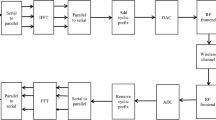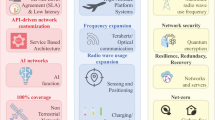Abstract
Multi-Input Multi-Output system (MIMO) is a wireless technology that employs transmitters and receivers for simultaneously transferring more amount of data. And Non-Orthogonal Multiple Access (NOMA) is a new technology that accommodates multiple users in the same spectrum to ensure efficient spectral usage. A combination of MIMO-NOMO systems meets the data demands of more users, while ensuring spectral efficiencies. This paper presents a new precoding algorithm using the Gaussian Mixture Modelling (GMM), which is a type of Machine Learning (ML) algorithm used for Clustering, for the MIMO–NOMA systems. Clustering refers to the grouping of data points into clusters. The use of optimal precoding methods would help eliminate inter–cluster interferences. The suggested precoding approach supports multi-layer transmission in multi-antenna wireless communications, incorporating the idea of GMM in a Multiple antenna system at both the transmitting and receiving ends along with a special case of its multiple access methodology being non-Orthogonal. Hence, the resultant MIMO–NOMA system would result in better spectral efficiency and energy efficiency. The simulation results prove this.












Similar content being viewed by others
Data availability
Dataset should be provided base on request.
References
Al-Imari, M., Xiao, P., Imran, M.A., and Tafazolli, R.: Uplink nonorthogonal multiple access for 5G wireless networks. In: Proceedings 11th International Symposium on Wireless Communications Systems (ISWCS), pp. 781–785, (2014)
Benjebbour, A., Li, A., Saito, Y., Kishiyama, Y., Harada, A., Nakamura, T.: System-level performance of downlink noma for future LTE enhancements. In: IEEE globecom workshops, pp. 66–70 (2013)
Choi, J.: Non-orthogonal multiple access in downlink coordinated two-point systems. IEEE Commun. Letters 18(2), 313–316 (2014)
Dai, L., Wang, B., Yuan, Y., Han, S., Chih-Lin, I., Wang, Z.: Non-orthogonal multiple access for 5G: solutions challenges opportunities and future research trends. IEEE Commun. Mag. 53(9), 74–81 (2015)
Ding, Z., Yang, Z., Fan, P., Poor, H.V.: On the performance of non-orthogonal multiple access in 5G systems with randomly deployed users. IEEE Signal Process. Lett. 21(12), 1501–1505 (2014)
Ding, Z., Schober, R., Poor, H.V.: A general MIMO framework for NOMA downlink and uplink transmission based on signal alignment. IEEE Trans. Wirel. Commun. 15(6), 4438–4454 (2016)
Ding, Z., Lei, X., Karagiannidis, G.K.: A survey on non-orthogonal multiple access for 5G networks: research challenges and future trends. IEEE J. Select. Areas Commun. 35(10), 2181–2195 (2017)
Ding, Z., Fan P., Poor, H. V.: Impact of user pairing on 5G non-orthogonal multiple access. IEEE Trans. Vehicular Technology (submitted) Available on-line at arXiv:1412.2799.
Ding, Z., Adachi, F., Poor, H.V.: The application of MIMO to nonorthogonal multiple access, IEEE Trans. Wireless Commun. (submitted) Available on-line at arXiv:1503.05367.
Jain, M., Soni, S., Sharma N., Rawal, D.: Performance Analysis at near and far users of a NOMA System Over Fading Channels. In: 2019 IEEE 16th India Council International Conference (INDICON), pp. 1-4 IEEE, (2019)
Larsson, E.G., Edfors, O., Tufvesson, F., Marzetta, T.L.: Massive MIMO for next-generation wireless systems. IEEE Commun. Mag. 52(2), 186–195 (2014)
Liu, Y., Pan, G., Zhang, H., Song, M.: On the capacity comparison between MIMO–NOMA and MIMO-OMA. IEEE Access 4, 2123–2129 (2016)
Liu, Y., Pan, G., Zhang, H., Song, M.: On the capacity comparision between MIMO–NOMA and MIMO-OMA. IEEE 4, 2123–2129 (2016)
Wang, B., Wang, K., Zhaohua, L., Xie, T., Quan, J.: Comparison study of non-orthogonal multiple access schemes for 5G. IEEE (2015). https://doi.org/10.1109/BMSB.2015.7177186
Wang, H., Zhang, R., Song, R., Leung, S.-H.: A novel power minimization precoding scheme for MIMO–NOMA uplink systems. IEEE Commun. Lett. 22, 1106–1109 (2018)
Funding
This study did not receive any funding in any form.
Author information
Authors and Affiliations
Contributions
All authors have equal contribution.
Corresponding author
Ethics declarations
Conflict of interest
The authors have no relevant financial or non-financial interests to declare relevant to this article’s content.
Consent for publication
The authors provide consent for publication in this journal.
Consent to participate
Not applicable.
Ethical approval
Not applicable.
Additional information
Publisher's Note
Springer Nature remains neutral with regard to jurisdictional claims in published maps and institutional affiliations.
Rights and permissions
Springer Nature or its licensor (e.g. a society or other partner) holds exclusive rights to this article under a publishing agreement with the author(s) or other rightsholder(s); author self-archiving of the accepted manuscript version of this article is solely governed by the terms of such publishing agreement and applicable law.
About this article
Cite this article
Markkandan, S., Aggarwal, K., Ashok, K. et al. Design of precoder for a MIMO–NOMA system using Gaussian mixture modelling. Opt Quant Electron 56, 60 (2024). https://doi.org/10.1007/s11082-023-05655-2
Received:
Accepted:
Published:
DOI: https://doi.org/10.1007/s11082-023-05655-2




